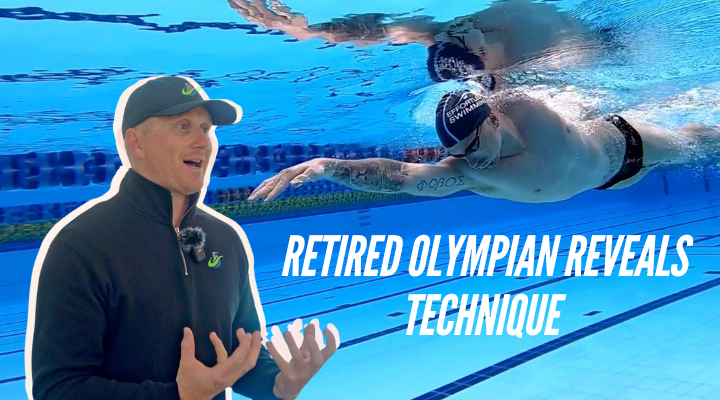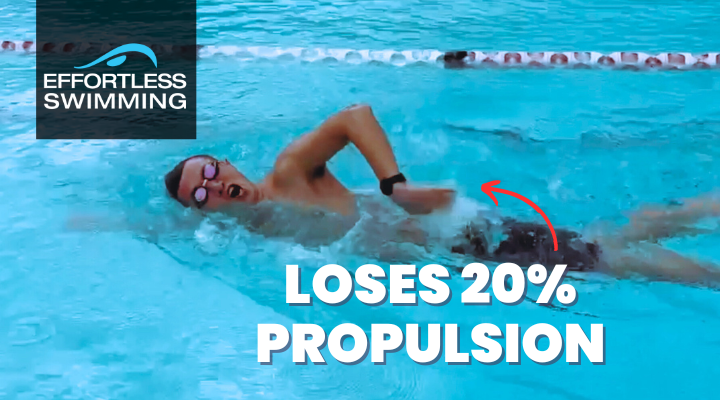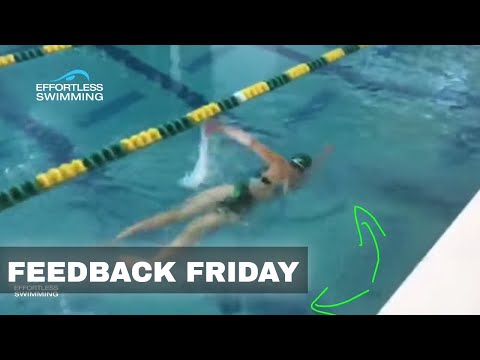Is it okay to look forward? Not directly forwards, but a few meters in front? For triathlon and open water swimming, it can be helpful for maintaining your awareness about what’s around AND it can help with posture and position in the water.
Transcription:
And often there are so many different ways to describe the different kinds of things that you want to do when you’re swimming.
One thing that you will have seen in our videos over the last couple of years is I talk a lot about posture and head position. And on a podcast recently that I did with Eney Jones, who’s a coach that I’ve learned a lot from, one of the things that she likes to talk about if you’re a triathlete or an open water swimmer is you probably want to look somewhat forwards, obviously not straight forward, that’s going to be too high, but you can look around 45 degrees forwards as in if straight down is zero, 45 is maybe two meters in front of you. You still want to keep a neutral neck and spine, neutral as in straight. You don’t want a big kink in the back of your neck, it can impact your core, but you want to look somewhere forwards.
Now, a couple of reasons for that. The first one is it’s going to give you much better awareness around what’s in front of you. And if you’re swimming in the open water and your head is straight down, you’re not going to know what’s coming up in front of you. Obviously you’ll be siding, yes, you can see what’s happening there, but in general, you don’t have great awareness of it. And it can be much, much easier and much more helpful to know roughly what’s in front, whether there are other swimmers, whether there’s rocks or things coming up. So looking slightly forwards can help you with your awareness in the open water.
But the other thing that can help with that as well is it can help you sit up a little bit higher in the water. So if your head’s completely submerged, if it’s all the way under the water, for most people I find that’s too deep. You want to keep the top of your head, your crown of your head above the water, looking maybe one or two meters in front, keeping the neutral neck and spine. And the way I like to teach it is feel like you’re lengthening through the back of the neck like you’re being pulled up from above like there’s a piece of string through your neck and through your spine and it’s lengthening you out through there. That’s going to sit you in this tall and proud posture that will allow you to use those stronger muscles through the back and through the shoulders.
And another thing that Eney mentioned on the podcast that I did with her recently, and I’ll put a link below to our podcast if you haven’t subscribed to it yet. In that podcast, she talks about leading with the heart. So we talk about swimming tall and proud. She talks about it as leading with the heart as in chest out. And that can be a very, very good way to swim because that’s going to give you that same posture that we talk about. And often there are so many different ways to describe the different kinds of things that you want to do when you’re swimming and whether it be swimming tall and proud or lead with the heart, either one of those might work best for you.
And whichever one it is, it doesn’t matter, but as long as you find that posture where you feel strong and you sit nicely in the water where hopefully the shoulders are sometimes out of the water and the top of the head’s out of the water. Because if you’re trying to swim completely underneath it, that can feel a lot harder.
And I’m not a big fan of the term swimming downhill because sometimes that’s not how it should feel. Swimming downhill, yeah, you want it to feel easy if that’s the reference you’re taking from it, but not necessarily swimming all the way under the water, you want to sit somewhat high. And you’ll see that with the best swimmers, especially in triathlon and open water swimming. They’re sitting on top of the water. Look at [inaudible 00:03:13], have a look at Harriet Brown in this video here. They sit somewhat high in the water and that’s where I find, especially if you’re just doing triathlon, you’re an age grouper, then you don’t want to be swimming so deep because it’s going to make it a lot harder to do, a lot harder to swim and maintain your pace. So there are just some of the things that can help you in terms of your posture and your head position and it can give you much better awareness in the open water if you find at the moment you’re looking down too deep.
And sometimes a question that I get from people is, “Well, doesn’t your head position determine what happens at the back of your body?” To a certain extent it does, you need to press down with your chest and your head a little bit. Obviously you can’t be sitting up too high because it will drop the legs. But your hips and your legs aren’t determined purely by your head position. Somewhat, yeah, a little bit, but it really comes down to what are your hips doing, what’s your core doing, and are you engaging your glutes? It comes down to what’s happening below that, only to the point obviously where there’s still that little bit of downward pressure there. But your head isn’t the only thing that impacts where your legs are and where your hips are at the back. So that’s why we don’t want to be looking so far down that the head’s completely submerged.
I’d like to know your thoughts below, so let me know what you think of that. Is it something that you currently do in your swimming and what have you found by changing your head position? Because it really is a lever that you’ve got to improve your body position and improve your posture. And even swimmers at the very top end, they’re making these very small changes with their head position to change their posture, how they’re sitting in the water and having their awareness in the water as well.
So let me know what your thoughts are below. Looking forward to seeing you next week. Make sure you like and subscribe if you haven’t already and I’ll catch you next week with another video.









